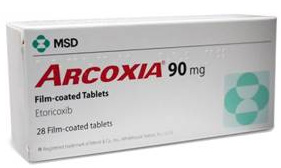Medication Overview: Arcoxia
Arcoxia, generically known as etoricoxib, is classified as a nonsteroidal anti-inflammatory drug (NSAID) specifically functioning as a selective COX-2 inhibitor. Employed widely for its anti-inflammatory and analgesic properties, it serves in managing conditions such as rheumatoid arthritis, osteoarthritis, and ankylosing spondylitis. In clinical practice, Arcoxia is favored for its targeted mechanism, aiming to reduce gastrointestinal side effects prevalent with other NSAIDs. As a prescription medication, healthcare providers determine its suitability based on patient-specific health evaluations.
Pharmacological Properties
Etoricoxib, the active component of Arcoxia, exerts its effects by selectively inhibiting cyclooxygenase-2 (COX-2) enzymes responsible for inflammatory processes. This selectivity helps in mitigating pain and swelling while maintaining gastric mucosal integrity, an issue frequently compromised by non-selective NSAID use. The molecule exhibits high oral bioavailability, ensuring effective absorption and action upon administration. Metabolized primarily by the liver, it is excreted predominantly through urine, necessitating consideration of liver and renal functions before initiation.
Therapeutic Indications
Arcoxia is prescribed primarily for symptomatic relief in conditions such as osteoarthritis, rheumatoid arthritis, ankylosing spondylitis, and acute gouty arthritis. In osteoarthritis, it alleviates joint pain and improves mobility, supporting long-term management strategies. For rheumatoid arthritis, it aids in reducing joint inflammation, contributing to enhanced functional capacity over time. In ankylosing spondylitis, the medication diminishes spinal inflammation, providing relief from chronic pain and stiffness. Its role in acute gouty arthritis treatment is predicated on rapid pain relief and inflammation reduction.
Administration Guidelines
Arcoxia should be taken orally, with or without food, adhering strictly to the prescribed dose and schedule set by the healthcare provider. Consistency in timing enhances therapeutic efficacy and minimizes side effects. Dosage adjustments may be necessary in response to patient feedback regarding symptom control and any emerging adverse effects. Swallow tablets whole with water, avoiding crushing or chewing to maintain the integrity of the drug delivery system. Changes to dosage or frequency should not occur without medical consultation.
Dosage Specifications
Recommended dosages of Arcoxia vary based on the specific condition being treated. For osteoarthritis, a daily dose typically ranges between 30 to 60 mg, while rheumatoid arthritis requires up to 90 mg. In ankylosing spondylitis, a similar dosage of 90 mg may be employed. Acute gout treatment often calls for a higher 120 mg dose, typically limited to an 8-day course to mitigate adverse effects. Dose adjustments should consider patient-specific factors such as age, weight, liver function, and the presence of coexisting medical conditions.
Contraindications Details
Arcoxia is contraindicated in patients with known hypersensitivity to etoricoxib or any formulation components. Individuals with a history of peptic ulcers, gastrointestinal bleeding, severe hepatic dysfunction, or inflammatory bowel disease should avoid the drug. Additionally, it is inadvisable for those with severe heart failure, ischemic heart disease, peripheral arterial disease, or cerebrovascular disease. Arcoxia should not be used during pregnancy or breastfeeding without professional evaluation for potential risks.
Adverse Reactions Observed
Potential adverse reactions associated with Arcoxia use include dyspepsia, abdominal pain, hypertension, and headaches. Less commonly, patients may experience dizziness, edema, or renal impairment, necessitating immediate medical attention. Cardiovascular risks, although reduced compared to non-selective NSAIDs, require monitoring, particularly in patients with existing cardiovascular concerns. Any suspected allergic reaction, such as rash, swelling, or difficulty breathing, demands prompt cessation and assessment.
Drug Interactions Explored
Arcoxia has known interactions with anticoagulants, increasing bleeding risk, requiring close monitoring when used concurrently. Co-administration with other NSAIDs or aspirin may enhance gastrointestinal side effect risk, thus generally discouraged. Interaction with lithium can result in elevated lithium levels, necessitating regular monitoring of serum concentrations. Additionally, the effectiveness of antihypertensive medications may be diminished with concurrent Arcoxia use, warranting periodic blood pressure assessments.
Monitoring and Assessment
Patient response to Arcoxia therapy should be regularly evaluated, considering both therapeutic benefits and potential adverse effects. Routine assessments might involve liver function tests, renal function evaluation, and blood pressure monitoring. Patient feedback on symptom relief and quality of life aids in determining the continued appropriateness of the medication. Adjustments to the therapeutic regimen may be necessary based on these evaluations and any evolving health status changes.
Patient Counseling Points
Patients should be informed about the importance of adhering to prescribed doses and schedules, while promptly reporting any side effects. Understanding the potential impact of Arcoxia on preexisting conditions like hypertension is crucial for patient awareness. Educating on recognizing signs of serious adverse reactions, such as abnormal bleeding or severe allergic responses, facilitates timely intervention. Patients should also be advised to avoid alcohol and other NSAIDs to minimize gastrointestinal risk.
Storage and Handling Guidelines
Arcoxia should be stored at room temperature, away from excessive moisture and heat, to maintain its stability and efficacy. Tablets must be kept in their original packaging, well-protected from light and out of reach of children. Handling should involve clean hands, and splitting of tablets is contraindicated to preserve the intended drug release mechanism. Expired medication should be disposed of according to local regulations, ensuring environmental safety.








Reviews
There are no reviews yet.